You may have heard this story: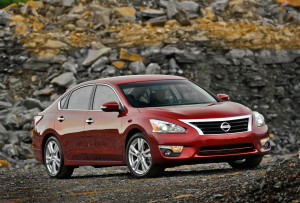
Back in the mid ’60s, that wild and crazy guy John Z. DeLorean – father of the GTO – almost fathered a Pontiac rival to Chevy’s Corvette. It was a slick two-seater called Banshee (internally, XP-833) that got disappeared as soon as GM upper management discovered what he was up to.
Enter the 2014 Nissan Altima.
Well, exit the 2014 Nissan Altima coupe.
It’s been retired – after having been horribly gelded last year.
Nissan pulled the formerly available V-6 engine – and the manual transmission. The only way you could buy a 2013 Altima coupe was with the four cylinder engine paired with a CVT automatic.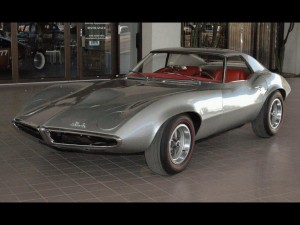
Which probably explains why there’s no 2014 Altima coupe.
Now, this is just my theory – but maybe Nissan management regarded the two-door Altima much the same way as Mad Men era GM management regarded John Z’s Banshee: As an internal threat.
To the 370 Z sports car.
After all, the Altima coupe looked a lot like the Z – even if it was front-wheel-drive (while the Z is, of course, rear wheel drive). And it had – until they pulled it from the roster – the same basic V-6 engine/six-speed manual transmission combo.
It also had a much lower price – just like the stillborn Banshee would have had relative to Corvette. And that might have been its fatal flaw.
But, there’s still a way to pull a DeLorean at your local Nissan store. Take a look at the 2014 Altima sedan’s stats. You’ll find it’s about the same size outside – and actually has more room inside – than the considerably pricier Maxima sedan.
You can order it with the same basic V-6 engine – and thusly equipped, it outperforms the Maxima, too.
And – here’s the bell ringer – you can get a V-6 Altima for about $5k less than you’d pay for the Maxima.
Gather ye rosebuds while ye may . . . .
The Altima is Nissan’s mid-sized, mid-priced sport sedan. It also happens to be Nissan’s largest sedan.
It’s about the same size on the outside – and roomier inside – than the much more expensive Maxima sedan.
And it’s available with the same 3.5 liter V-6 engine that’s standard in the Maxima (and shared with Nissan’s Z-car sports car).
Base price is $22,170 for the 2.5 sedan . . . and you can get into a V-6 powered Altima for $26,320 vs. $31,290 to start for the Maxima.
You might also cross-shop the Honda Accord – which is slightly quicker but costs a lot more ($30,345 w/the V-6).
Or the Mazda6 – which is a very attractive and fun to drive car – but which no longer comes with a six at all.
The ’14 Altima is fundamentally a carryover (having been “all new” in 2013) but there are a number of key upgrades for the new model year, including available Pandora and Facebook connectivity (god help us) via NissanConnect, a Moving Object Detection (MOD) system and a “curve warning” system (integrated with the navigation system).
A “DriveAssist” display with 3D graphics (located in the main gauge cluster between the speedometer and tachometer) is now standard in all trims.
For those more interested in driving, there’s a new Sport Value package that can be ordered with S models. It gets you an upgrade wheel/tire package, trunk mounted spoiler and remote-start (via the key fob). There’s also an upgraded touchscreen LCD display monitor, if you order the Display Audio package.
As mentioned above, the coupe has been discontinued.
Roomier inside in several key categories than the Accord.
Roomier in all categories than the Maxima.
Still available with a V-6.
“Zero gravity” seats are easy on your . . . .
Straightforward controls.
WHAT’S NOT SO GOOD
No more coupe.
No more manual transmission – with either engine.
Less personality than previously.
Some uber-annoying “safety” gadgets.
Standard equipment is a182 hp 2.5 liter four-cylinder engine paired up with a continuously variable (CVT) automatic. This version of the Altima can get to 60 in about 7.8 seconds – a solid half second improvement over the previous generation Altima sedan.
And – bonus ! – the 2.5 liter engine is also capable of delivering 27 MPG city and 38 MPG, numbers that just three or four years ago would have been considered top drawer from a compact economy car.
The CVT automatic gets most of the credit for the MPG uptick. It’s more efficient than a manual – or a conventional (hydraulic) automatic. This is why CVTs are becoming commonplace – and will probably replace traditional (hydraulic) automatics in most cars within a handful of years.
You can also upgrade to a 3.5 liter, 270 hp V-6.
Equipped with this engine the 0-60 time dives down to a very quick 6.2 seconds – among the quickest times in this class. Fuel economy is also very good with this engine: 22 city, 31 highway. 
The standard – and only – transmission is once again Nissan’s excellent (but take-it-or-leave-it) CVT automatic.
Some sport-minded buyers may be put off by the absence of a third pedal – especially in view of the fact that several of the Altima’s main rivals – including the Accord and Mazda6 – are still available with manual transmissions.
However, Honda only offers the stick with the four – and Mazda only offers a four, period.
All versions of the Altima are – like the others in this segment- front wheel drive.
Over the past several years, the Altima gradually, almost imperceptibly, became what the Maxima once was – Nissan’s sportiest four-door model. When the Maxima lost its manual transmission and evolved into a still-powerful but more luxury-minded touring car, the Altima stepped in to fill the void as Nissan’s hot-shoe sedan. It was almost the same size overall (still is) and it had (and can still be ordered with) the same basic Z-car sourced/shared V-6 engine.
But most of all, you could get that sweet-sounding (and sweet-pulling) six in the sedan . . . and with a manual transmission.
Thusly equipped, the Altima became for all practical purposes, the new Maxima . . . . just with a different name.
I’m not sure what the Altima is now.
Or rather, what its role is in Nissan’s lineup – other than as a lower-cost alternative to the Maxima.
It is still an athletic car – even with the base four-cylinder engine. With the V-6, it will outrun most of the other cars in this class.
Handling is excellent, too.
The ’14 Altima (all trims) features an Active Understeer Control System that counteracts the built-in tendency of a front-wheel-drive car (which is nose heavy, due to the weight of the engine/transaxle up front) to feel as though it’s plowing toward the outside of the curve rather than tracking with your steering inputs through the curve. The system lightly applies braking pressure to the inner wheels (front and rear) during cornering to keep the car settled and feeling to the driver like a rear-wheel-drive car. This all happens automatically – with no physical sensation it’s happening.
Brilliant.
As in the Maxima, there’s not much for the driver to do anymore. Push the accelerator and the car goes – swiftly, quietly.
Turn the wheel – and the car turns. And goes exactly where you point it.
But, without a clutch to push in, without gears to row – something important has been lost. What’s the difference between the Altima V-6 and the Maxima in terms of how each car drives, rides and handles?
Not much.
Though the Maxima’s version of the 3.5 liter engine rates higher – 290 hp vs. the Altima’s 270 – acceleration is virtually the same. The Maxima does 0-60 in about 6.2 seconds – and so does the V-6 Altima. They’re neck-and-neck past the checkered flag, despite the Maxima’s on-paper power advantage – because the Maxima is heavier by several hundred pounds. 
Handling (and ride) wise, they’re also very close – because they’re so closely related.
Perhaps too closely related.
The question arises: Why buy the Maxima? And the answer is: Because it’s more luxurious – fitted out with more in the way of standard amenities.
The Maxima has become Nissan’s almost-Infiniti sedan.
Which prompts the follow-up question: Why buy the Altima?
Because it’s roomier than the Maxima, feels/drives a lot like the Maxima . . . and because it costs a lot less than the Maxima.
The ’14 Altima is the biggest Altima so far. Bigger, in fact than the Maxima – which is odd given that – usually – the top-dog model (that would be the Maxima) is the largest/roomiest model in a given automaker’s lineup.
The wheelbase is the same as the previous generation Altima (109.3 inches) but the current car is about an inch longer (191.5 inches vs. 190.7 inches) and both the front and rear track (distance between the wheels) has been significantly increased to 62.4 inches in front and back vs. 61 inches before.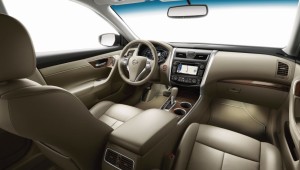
Visually, this gives the Altima a wider/hunkier stance. Functionally, it allowed Nissan to carve out a bit more space inside for passengers. There’s almost an extra inch of front seat legroom (45 inches now vs. 44.1 before) and a wee bit more legroom in back, too (36.1 inches vs. 35.8 before). Shoulder room is noticeably more generous: 56.4 inches in front and 56.1 in the back seat vs. 55.7 up front and 55.5 in back for previous-gen. Altima.
This – interior roominess – is an area where the Altima smokes the Accord. The Honda has only 42.5 inches of front seat legroom, though this is made up for by very generous legroom in the back seat (38.5 inches). This is nice, of course . . . for the Accord’s backseat occupants. But taller drivers will find the Altima (which also has more headroom up front) much more accommodating.
What’s really noteworthy, though, is that the Altima’s interior is roomier than the Maxima’s. And not by a little bit, either. In the Maxima, there’s only 43.8 inches of up-front legroom – and in the back, just 34.6 inches. There’s also less shoulder and head room.
Oh, and the Altima sedan also has a bigger trunk: 15.4 cubic feet vs. 14.2 for the not-so-Maxima.
The shifting emphasis toward practicality (roominess, fuel economy) and comfort is also apparent as far as the new Altima’s “zero gravity” seats – which Nissan says were designed using NASA’s astronaut research to relieve pressure point areas – you know, the ones that make your butt go numb on long road trips. And they are noticeably more comfortable, not only vs. the previous Altima’s seats but vs. the seats in other cars in this segment, such as the Accord. The doors in my test car were also softy padded with a cushy looking and feeling velour-type material – including the arm rests.
If you order the V-6 equipped Altima 3.5S, you’ll get an upgraded 18-inch wheel/tire package (16s are standard), better brakes and a Sport mode for the CVT automatic with steering wheel-mounted paddle shifters for manual control. This version of the Altima is a performance deal. A comparably kitted out V-6 Accord is almost five grand more to start.
If only you could still order the Nissan with a stick. . . .
The one thing – the only thing – I really dislike about the new Altima is the “curve warning” system – which is integrated with the optional GPS. It will drive you batty – and possibly, drive you off the road.
Not one but two annoying electronic chimes assault you – the first an owl-like sound as you approach a curve, followed by a sharper beeping noise as you enter the curve. A little warning icon indicating “curve ahead” – and distance to curve – appears in the lower right corner of the LCD display.
On a curvy road, the literally incessant eruption of obnoxious beeps and chirps is more distracting than a pair of eight-year-olds fighting in the back seat. Thank god, the GPS system is optional and – I assume – it is possible to turn off the curve warnings. (I was unable to figure it out; there’s no obvious “off” button – and Nissan didn’t provide an owner’s manual with my press car test car.)
The Altima may no longer come with a manual – or be available in two-door form. But it is available with most of what you get in the Maxima . . . for a lot less coin.
Somewhere, John Z. is probably smiling.
Throw it in the Woods?






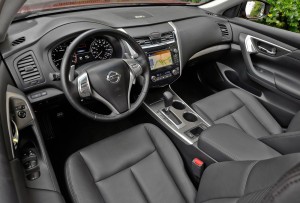
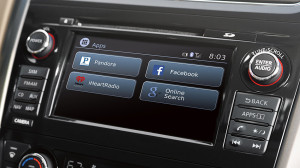



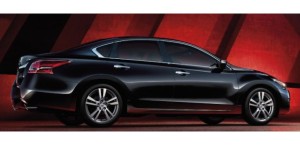








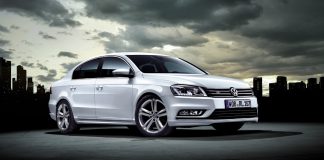
I have a 2001 Altima — had it for about ten years now, actually. It’s served me very well, and even got me all the way across the continent to this crazy place. When the old girl finally needs replacing, I could definitely be persuaded to get a new Altima, but only if that ridiculous curve warning can in fact be disabled. That is the most looney-tunes “safety feature” I have ever heard of in my life. I thought the “slip alarm” on my Yaris was obnoxious!
This whole state is nothing BUT curves. It would be chiming constantly.
Ditto Darien!
I love the car – but that hoo-hoo (and chirp chirp) shit has got to go.
eric, I’ve owned exactly one car I didn’t pull the unit that makes noise. I even pulled it after starting but before test driving a Nissan pickup. The salesman looks at me as I got down and jerked it out and says “sumbitch does sorta drive you up the wall”. No shit. And I ain’t listening to it. It was a good ride without it and I bought the damned thing……chirp box in the console compartment where I chunked it.
Back to the Banshee. I was hot for that car, had lots of plans for it. They had that six in a Le Man’s and seems like another car and it would ball the jack very well, was really refined and seamless type power(I had a teacher who owned one and would often let me drive it). I’d drive the whee out of it and he never said anything but I mainly just used WOT and let the auto do it’s thing. It had a neat feature I liked too. When you stuck your foot far enough into it the a/c compressor would turn off and only come back on when the load lessened. That engine sounded good. My thinking was the shitty little warranties they had back then would let you get a good feel for the car and then you could sub a 327 with all the goodies and and eat the muscle car crowd up no matter what they were driving. To this day I can’t think about any vehicle without considering how to make it go faster, corner better and stop faster. I don’t think most people who should know it understand a 327 had the ability to crank out 420 hp reliably. I don’t recall a two bolt crank engine of any sort that would rev like the 327. I had to put a lightweight flex fan on one I had along with the better alternator cooling fan/pulley since the cheaper units would shed vanes and raise bumps on the top of the hood. No telling how fast that little car would have run with a SBC.
swamprat wrote, “a cross between a 69 Vette and an Opel GT. Damn. That would have been a hot car.”
Mithrandir wrote (on another thread) “The answer is easy for me. She is pretty.”
Ya. That’s All cool…. and, hot.
No doubt!
For some reason it reminds me of a scene in, ‘The Moon is Down’.
The soldiers of today thought they could approach things the same with a different outcome?
They thought they could say, “Hi” to the pretty occupied girl and she would accept them? …As if Nothing had changed, as if they were in their old world where things seemed to make sense?
In the background I imagine the soldiers fought off demon images of killing children and women.
How horrible it must all be.
The Big Pharma drugs they were likely given probably didn’t help things much. [Big Pharma Bastards].
Those soldiers can’t enjoy a cross between a 69 Vette and an Opel GT,…. or a hot chickas.
Maybe that’s why, ‘Military killing themselves in record numbers’?
http://groundreport.com/military-killing-themselves-in-record-numbers/
I feel sorry for them, they couldn’t find a way out.
They were led astray.
Like most of us.
And the so-called leaders at the local level said nothing,.. or worse, they cheered them on?
Pardon me, I’m just thinking an unpopular true thought aloud.
…. Just move along. And nevermind.
As if the world is told, “Pretend it doesn’t exist”.
The Banshee looks like a cross between a 69 Vette and an Opel GT. Damn. That would have been a hot car.
Dear Eric,
I’ve always thought the Altima was a classy looking car. One with style that would not turn you off in a couple of years.
The zero gravity seats sounds like something I’d really like. On long distance trips I sometimes end up with “dead end.” lol
I discovered a minor typo in the “On The Road” section where cornering is spelled “corning”. Just in case you might want to correct it.
Good review of a classy looking car. Thanks.
Linda
Thanks, Linda – for the kind words … and the copy edit!
Current generation Altimas are kinda boring…But I don’t say that “like it’s a bad thing.” I see A Whole Lot of them here in the Southeast Valley. Nissan must have got the chemistry right. They appeal to the “auto as transportation appliance” crowd. But Nissan also added fairly appealing looks, and, for an almost economy car, pretty good performance. So Altima attracts a broad cross section of buyers.
I can’t work up enough emotion for this car to either like, or dislike it.
But Nissan must love the Altima…… a lot. Without it, they’d be hurting.
Right you are, Mike – the Altima is Nissan’s best-selling model in the U.S.
They definitely love it!